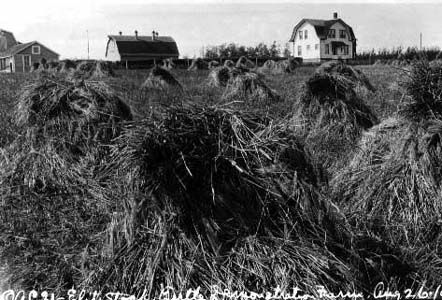Search | Image Archive | Reference | Communities | POV | Lesson Plans | Credits
 Threshing time was a significant social and economic event on the prairie farm. Between the 1880s and the 1920s, most prairie farmers relied upon commercial threshermen to complete the harvest.
Threshing time was a significant social and economic event on the prairie farm. Between the 1880s and the 1920s, most prairie farmers relied upon commercial threshermen to complete the harvest.
Threshing machines, also called separators, and the engines that drove them were expensive and complicated machines that required large crews to operate them. Few farmers owned their own equipment, but rather relied on commerical threshermen to complete the harvest. Thresherman, or custom threshers, were equipment owners who hired crews to travel from farm to farm at harvest time. In the late summer, the population of the prairies would swell as labourers from Ontario, British Columbia and the United States converged on the prairies to fill seasonal jobs. Many of these workers were "blanketstiffs" who passed the rest of the year at other temporary manual employment along the railway grades or in lumber camps. Sometimes they were hired in the east and transported to the prairies in special "excursion trains."
Before the threshing crews arrived, the grain was cut and stacked in stooks to dry in the field. At the same time, preparations would begin to feed the crews On threshing days, the size of the farm family would swell by as many as two dozen, and the task of cooking and providing for the crews occupied farm women and girls for many hours.
Under pressure to move from farm to farm and take in as many crops as possible before the frost came, threshing crews worked almost uninterrupted from dawn to dusk. Accidents related to fatigue were frequent and had tragic results. The belts that connected the tractors and separators had to be constantly adjusted, and the exteriors of the machines were covered with exposed belts and pulleys. Not infrequently, one of these belts would capture a piece of clothing, and many threshers lost hands and arms to the machines.
Harvesting and threshing was a time of intense activity and stress, and at the end of a successful year, when the grain had been separated and stored or shipped to the elevator, communities celebrated with community dances and agricultural fairs.
Page revised: 29 August 2009